Defining the Efficient Baseball Swing
A position player’s value is determined by their ability to hit, more than any other skill, because it contributes so much to winning. Two of the five tools a player can have center around hitting production – power and contact.
For years, hitting instructors have remained locked in the debate on which players represent the most efficient swing, using labels like “linear” or “rotational” to explain the swing approach. On a scale from contact hitters like Tony Gwynn and Ichiro, to pure power hitters like Chris Davis and Adam Dunn, lies a middle ground of balanced hitters like Mike Trout and Barry Bonds who seemingly represent our ideal swing approach.
Only recently, however, has technology allowed us to trace the full swing to have a clearer understanding of what makes up the best baseball swing.
Sabermetrics has established new ways of valuing hitters and understanding efficient offensive production, while modern technologies (Trackman, HitTrax, ZEPP, SportsVision, etc.) have finally enabled us to analyze and truly define the efficient swing. This has helped us begin to answer some of the common questions surrounding the baseball swing:
- Do we focus on swinging up or down at the ball?
- Do we focus more on hand path to make contact or on torque with the lower body while allowing our hands to be passive?
- What professional hitters should we emulate?
- Which hits have the most value and what is the exact value of each hit?
- What should my bat speed and swing angle be in order to square the ball up more consistently and increase my likelihood of getting the most valuable types of hits?
Physics: What Angles Create Optimal Baseball Swing?
Let’s start with a simple illustration….
We have a pitcher and a hitter both 6’0’’ tall. The pitcher is on a mound, meaning he’s now 10” taller than the hitter at the top of the mound and roughly 5” taller at landing. He’s most likely throwing overhand (99% of all pitchers do), so using an estimated wing span, the ball is now 5” plus 85% of the pitcher’s 1’6” wing span taller than the hitter at release.
As soon as the pitcher lets go of the ball, the ball is constantly slowing down due to wind resistance. If our pitcher is throwing from higher ground to a lower target with the ball constantly slowing down, we know the ball is ALWAYS going down, even at 100mph with exceptionally high spin rates. In fact, the documentary, “Fastball,” makes a point to disprove the idea that even the fastest fastballs do not rise, so we are safe to say the ball is traveling down no matter the pitch.
In order to consistently square up two round objects, the surface of one bat and one ball, given the downward trajectory of the ball, a hitter must swing even or slightly up through contact.
In his article in the Hardball Times, “Optimizing the Swing, Part Deux: Paying Homage to Teddy Ballgame,” Dr. Alan Nathan of the University of Illinois points to a study using Statcast data, in which on-base average is shown as a function of exit speed and launch angle.
The two regions of high on-base average are primarily red. One is the narrow strip extending from 110 mph/100 to ~66 mph/300. The high exit speed part of this strip represents hard-hit line drives with small launch angles, leading to a high on-base average. For the batter, these types of hits are highly desirable. The second important region occurs at high exit speed and launch angles in the 200-350 range. These are largely extra-base hits, primarily home runs.
Additionally, Dr. Nathan looked at BABIP (on-base average with home runs excluded) as a function of attack angle and offset paired with home run probability.
For BABIP, the red/orange strip results in an on-base average greater than about 0.75 and corresponds to launch angles in the range 90-170. The optimum swing parameters for high BABIP are 100and 0.5 inches for attack angle and offset, respectively, corresponding to an exit speed of 100 mph and launch angle of 120. On the other hand, home runs require a larger attack angle and larger offset, the optimum being 240 and 1.05 inches, respectively, corresponding to an exit speed of 101 mph and a launch angle of 290-300.
In simple terms, a professional player can get a base hit by either hitting the ball very hard between the infield and outfield or by hitting it hard enough over the outfield in the gaps or into the stands.
We’ve known these to be the best ways to get on base, but for the first time we have been provided a measureable understanding of what makes the hitter’s bat be in position to produce these types of hits.
The next question is: Does Dr. Nathan’s heat map data correspond to the swing data of players we statistically label as the best baseball hitters?
Based on these charts, we’d expect the best offensive players to consistently perform within the range of angles and exit velocities corresponding to extra base hits for higher run production and a higher BABIP, so launch angles of 90-300 with exit velocities of 100mph.
Statistics: How Do We Value Hitters and Who Do We Value Most?
Thanks to Sabermetrics, the statistical definition of an “efficient” hitter has been linked to maximizing run production by assigning linear weights, or run values to various types of hits.
Since maximizing runs is the ultimate goal, the statistically efficient hitter falls somewhere between pure power (a lot of homeruns with a lot of strikeouts) and pure contact (very little strikeouts, but not high slugging).
Weighted On-Base Average (WOBA) is the current “gold standard” by which we now measure a player’s offensive production, because it assigns actual run production values to types of base hits. Think of it as the very accurate version of Slugging Percentage. Since Major League Baseball statistically defines the “efficient” swing as the one that offers the most potential run production, WOBA serves as our finish line for the “efficient” swing approach. WOBA is defined as:
wOBA = [(0.69 × uBB) + (0.72 × HBP) + (0.89 × 1B) + (1.27 × 2B) +( 1.62 × 3B) + (2.10 × HR)]
/ (AB + BB – IBB + SF + HBP)
For simplification, let’s limit our sample of players to those who finished in the top 25 in WOBA in each of the last three seasons. We can look for consistencies in the mechanics and swing data of these players to validate the data in Dr. Nathan’s analysis.
The only players to be in the top 25 in WOBA for the last three seasons (2014-2016) are David Ortiz, Mike Trout, Miguel Cabrera, Anthony Rizzo, Nelson Cruz, and Edwin Encarnacion. Therefore, these hitters represent some of the most consistently high value MLB offensive producers in the last three seasons.
Over the course of the season, each of these players’ average launch angles range between 100-150 according to Statcast. The common denominator with these high value hitters is they elevate the baseball.
We’ve now statistically defined the efficient swing as the highest producing WOBA, and physically graphed an efficient swing as launch angles of 90-300 with exit velocities of 100mph. The last piece of the puzzle is defining the mechanics and approaches that produce these measurable results.
Mechanics: How Do We Swing Like the Best Hitters?
Using high-speed video to look at current high-value hitters (players with the consistently highest WOBA’s), we can see the commonalities in their swing mechanics.
By seeing where these mechanics overlap, we can determine hitting absolutes versus individual style. Below is an illustration of such mechanics among today’s top hitters. It is a visual road map for training the “efficient” swing as defined earlier. Notice the individual styles allowed in the beginning and end of the swings, but the absolutes that must be accomplished by all hitters between phases 3-7. Notice that every top hitter uses their feet/hips to create bottom-up torque, allows their hands to be relaxed and passive, and swings even or slightly up to match the incoming pitch plane and put the ball in the air for maximum potential run production.
Key Points
We want to swing and perform like the best MLB hitters. We define “best” as highest offensive production, or highest run producing potential, represented by the stat WOBA. The defined best baseball hitters overlap in their swing mechanics and resemble swings like Mike Trout, Miguel Cabrera, Anthony Rizzo, Nelson Cruz, and Edwin Encarnacion.
Those hitters’ swing approaches share many common points:
- Use the feet/hips to create bottom-up torque with relaxed/passive hands.
- Swing even or slightly up to match the incoming pitch plane.
- Put the ball in the air for maximum potential run production success.
These swing mechanics overlap our observed ideal swing angles from simulated bat/ball collisions, heat map data, and stat-cast data to confirm these swing mechanics represent the efficient baseball swing – the swing with the highest run producing potential.
In conclusion, if we want to perform like the best MLB hitters, we must train to use our feet/hips to create bottom-up torque with relaxed/passive hands, swing even or slightly up to match the incoming pitch plane, and put the ball in the air for maximum potential run production success.
Brantley Freeman
Latest posts by Brantley Freeman (see all)
- The Proper Way For Baseball Pitchers To Push Down The Mound - January 23, 2018
- Defining the Efficient Baseball Swing - August 22, 2017

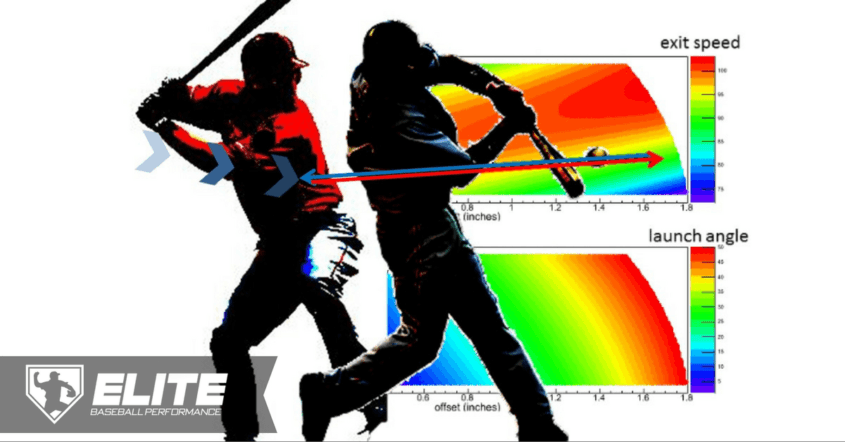
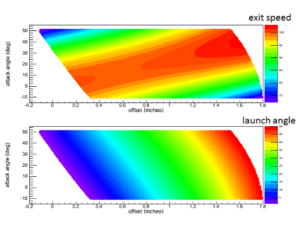
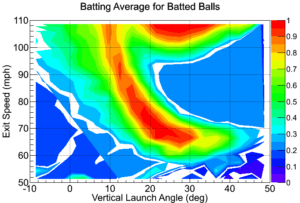

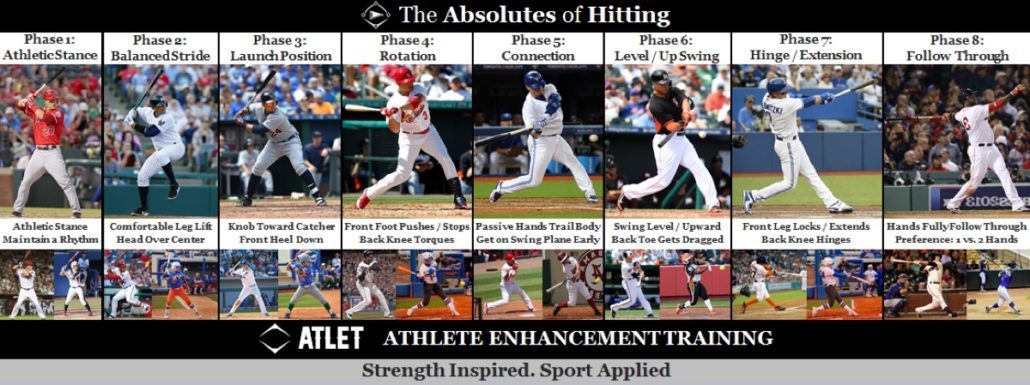

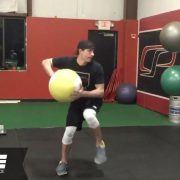

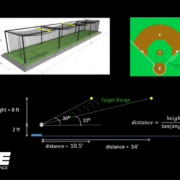




I found this article very helpful. Thank you. You mentioned WOBA and I have always wondered why HBP has a higher run weighting than BB.Since HBP produces a dead ball there would be fewer opportunities for scoring than on BB where runners could advance on a WP, PB or throwing error. Do you have any insight that would help me understand this better?
very insightful. Is there any statistics that looks at the relationship between pitch location (specifically the height) and launch angle/exit velocity and subsequently WOBA? Thanks
wonderful article thanks for sharing the great information
Wow. That’s really amazing! Thank you for sharing this useful information with us.